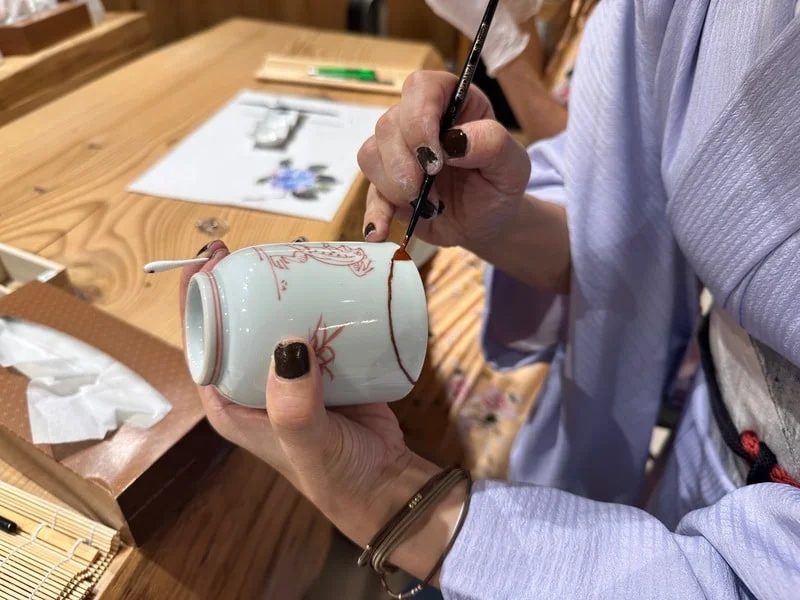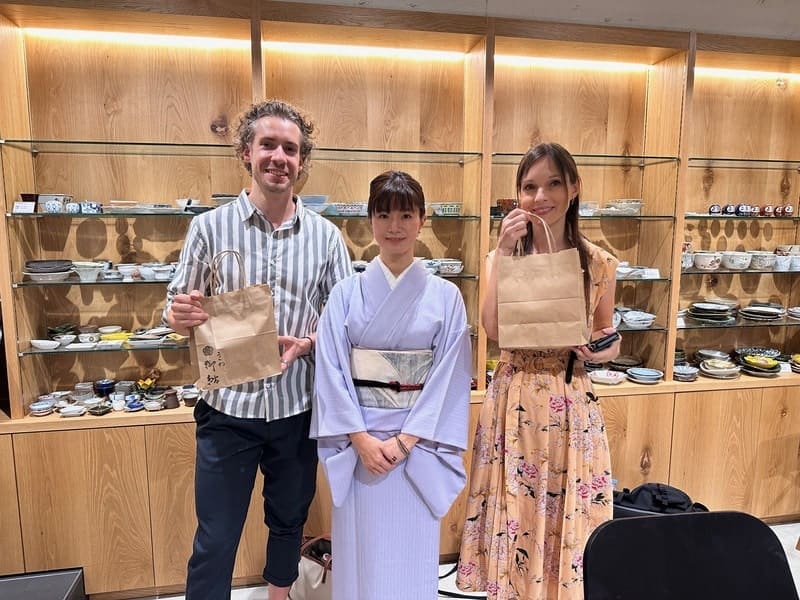Kintsugi is one of those things that you can only truly experience in Japan. If you’re interested in this form of art, then a visit to a kintsugi workshop is a must-do. And I’ve listed the best classes you can attend while in Japan, including the one I personally went to in Tokyo (one of the best you can find).
If you’re interested in Japanese traditional art forms, you might want to check my article about cultural and traditional things to do in Japan, where I list all the best activities to do during while visiting.
What is Kintsugi: Philosophy and History
Kintsugi, also known as “golden joinery,” is a unique Japanese art form that transforms broken pottery into a new, beautiful work of art. It is done by repairing cracks with lacquer mixed with powdered precious metals like gold, silver, or platinum.
This art is based on the Japanese philosophy that the history of an object is important, so kintsugi not only restores the item but also enhances the object’s aesthetic and sentimental value.
By highlighting the cracks, kintsugi reflects the concept of mushin (無心), which means “no mind.” This idea encourages us to live in the moment and accept change and imperfection as natural parts of life.
Kintsugi is believed to have started in the 15th century when a Japanese shogun, Ashikaga Yoshimasa, sent a broken Chinese tea bowl back to China for repair. He didn’t like the metal staples used to fix it, which led Japanese artists to develop a more beautiful way of repairing pottery.
This technique is closely connected to the Japanese tea ceremony and ideas like wabi-sabi, which values imperfection, and “mono no aware,” which is about appreciating the beauty in things that don’t last forever.
But enough talking. Now it’s time for hands-on practice. The best way to do that is a kintsugi workshop in Tokyo or Kyoto. Just like with workshops to make your own chopsticks in Japan, you’ll be able to meet master kintsugi practitioners and dive deep into this art.
Why Hands-On Experience is Important for Understanding Kintsugi
When you join a kintsugi workshop, you go beyond theoretical knowledge. By actually working with the materials—feeling every imperfection in the ceramic, every nuance of the putty, and the transformative power of the lacquer that fills in the cracks—you finally truly understand the philosophy behind kintsugi.

In a kintsugi class, you also get hands-on guidance. Making mistakes is part of the learning process, and here you can correct them in real time with the help of an experienced instructor. And learning from a kintsugi expert who has dedicated their life to the craft makes the experience far more enjoyable and engaging than just reading books or watching DIY videos.
So, how do you choose the right kintsugi class? Let’s see the key things to consider.
What to Look for in a Kintsugi Workshop
Expertise of the Instructor
A well-qualified and experienced instructor can make a huge difference. They should have a solid background in both the practice and philosophy of kintsugi. You’ll want an instructor happy to answer your questions, and willing to provide personal guidance and help you transform your item into a piece of art. Read the reviews of the experience on the booking website to see what other people say about that.
Quality of Materials Used
From the ceramic pieces to the adhesive and the gold powder, quality matters. The materials used should be authentic and of high quality to ensure that you’re getting an authentic kintsugi experience. But except if the class is suspiciously cheap, this is not something you should be worried about in Japan.

Accessibility and Location
The workshop should ideally be easy to find and accessible by public transportation. Try to check its location on Google Maps before booking to make sure it is easily accessible. The venue also adds to the overall experience; for instance, a workshop in a traditional Japanese setting will provide a more authentic atmosphere.
Private or mixed class
Unsurprisingly, a private class will be more expensive than a mixed class with strangers. I tend to prefer private classes when I can afford them because I can really talk with the instructor and ask all the questions I want. I’m also less embarrassed about asking stupid questions or sharing personal experiences.

In any case before booking a kintsugi class in Tokyo or Kyoto, try to check the reviews and ratings. This will give you an idea of what previous participants thought of the workshop.
If this kind of deep, hands-on experience appeals to you, why not also make you own Japanese knife in a similar workshop setting? It’s another craft deeply connected to Japanese culture.
Top Kintsugi Workshops in Tokyo
I personally went to the first workshop in this list, Utsuwa Omusubi HANARE. You can read my full review here, but long story short: it was fantastic. Aya-san our instructor was a great teacher, I learned a lot, and left with a beautiful Japanese-style cup that I couldn’t be more proud of.
| Workshop Name | Location | Price | Noteworthy Details | Reservation Link |
| Utsuwa Omusubi HANARE | Minami-Aoyama, Tokyo | ¥29,000/person | – Private class (no mixed group) – Workshop location looks stunning – Utsuwa Omusubi is one of the top pottery shop in Tokyo – Japanese tea and snacks included – Duration: 120 minutes – Bring your item home after the lesson (carefully packed in a small wooden box) | Wabunka |
| TNCA Minami-Aoyama Studio | Omotesando, Tokyo | ¥9,000/person | – Wear traditional work clothes – You can bring your own item for the class – Mixed class with 10 participants – Duration: 60 minutes – Minimum age: 15yo – Bring your item home after the lesson | Viator or Klook |
| Kintsugi Souke | Toshima, Tokyo | ¥33,000/person | – Four hours workshop – Hosted by award-winning artist Showzi – Mixed class – 24-karat gold powder included in the price – Also offers 6-day and 12-day masterclasses | Airbnb Experience |
Kintsugi Experience in Kyoto: Top Workshops
| Workshop Name | Location | Price | Unique Features | Reservation Link |
| Shitaka Urushi | Shimogyo Ward, Kyoto | ¥26,000/person | – Private class (no mixed group) – An interpreter will accompany you – Very authentic and local venue – 161 years old establishment – Sign your item – Duration: 150 minutes – Bring your item home after the lesson | Wabunka |
| Custom workshop | Higashiyama Ward, Kyoto | ¥45,100/person | – Private class (no mixed group) – Acclaimed English-speaking kintsugi artist Mio Heki as instructor – Takes place in historic villa Akagane Resort Kyoto Higashiyama 1925 – Most premium kintsugi class available on the market – Duration: 120 minutes – Bring your item home after the lesson | Wabunka |

I’m not really good with my hands, but I loved the kintsugi workshop I did in Tokyo. It was challenging enough to be interesting, but not so difficult that it became frustrating. I was surprised by how easily I could slip into that “active meditation” state that kintsugi practitioners talk about: being absorbed in the task at hand that you forget your surroundings. If you’re looking for a unique experience to learn more about Japanese culture, and a souvenir to take back home, kintsugi will be the perfect workshop for you.


Comments are closed.